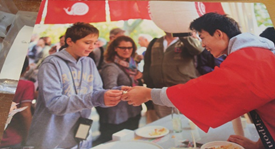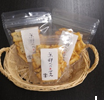Mochitake Arare
An exquisite hail that grows glutinous rice without pesticides in-house and makes Arare without additives
 |
 |
 |
| Mochitake Arare’s head Toshiki Takenaka |
Slow Food Tournament at Terra Madre-Salone del Gusto Italy (2016) | Love letter Arare to Kyoto |
Mochitake HP https://mochitake.theshop.jp/
Mochitake Instagram https://www.instagram.com/mochitake.kyoto/
Takeho Arare HP https://takehoarare.base.ec/
We have prepared “Kujo Negiarare” as a souvenir of the 4th “Love Letter to Kyoto”. I asked a Arare shop called Mochitake Arare. The head is a 30-year-old young man who grows glutinous rice in-house, which is rare in Japan, and makes additive-free Arare. It is a made-to-order Arare that is not sold in stores.
「As a souvenir of “Koibun to Kyoto”, we are preparing two kinds of soy sauce flavor of Sawai Shoyu and salt flavor of Kotobikihama using Kujo green onion and glutinous rice of Kyoto as raw materials. It is the ultimate Arare of local production for local consumption, all produced in Kyoto Prefecture. Mochitake Arare is said to have the goal of “creating a Arare that reminds us of the scenery of rice fields and the faces of the creators, by confining the charm of the land tightly, such as glutinous rice, salt, and soy sauce.” increase.
Arare, which has been eaten in Japan since ancient times, dates back to the time of Emperor Suinin in BC. It is said that happiness began when Okuninushi no Mikoto was told that “Happiness will come if you worship the red and white rice cakes on New Year’s Day.”
There is something as Arare smaller than a okaki. According to “Yamashiro Fudoki”, Arare rice cakes were produced as a kind of kaki mochi (dried sweets made by crushing Kagami mochi for New Year holidays) during the Heian period. There is also a theory that the origin of “Arare” is that the rice that was offered to the shrine was roasted and eaten when praying for a good harvest in the Nara period.
The world’s oldest restaurant, Aburi-mochi Ichiwa (Kita-ku, Kyoto), is made by cutting the “Okachin” offered at Imamiya Shrine into small pieces and grilling it on a skewer. The location has been the same for over a thousand years. Wells have been using well water from the same water vein for over a thousand years.
Arare, which has been eaten over a long history, has been useful both as a preserved food and as a sweet. Please enjoy the mariage of Kujo green onions and hail.
that’s all
